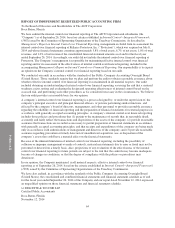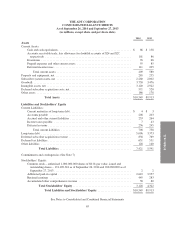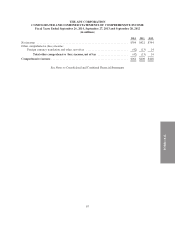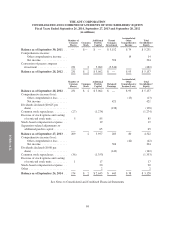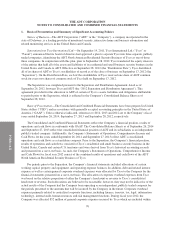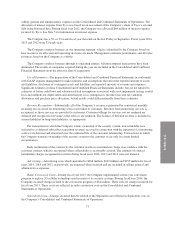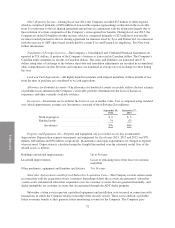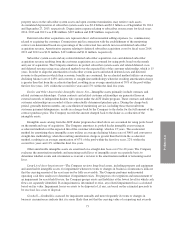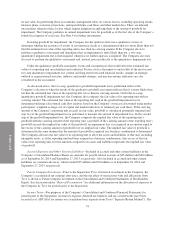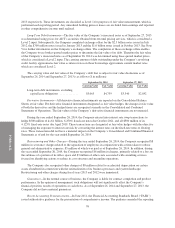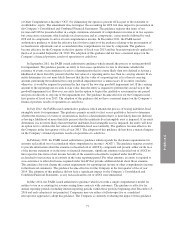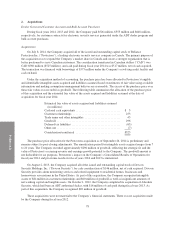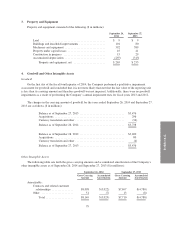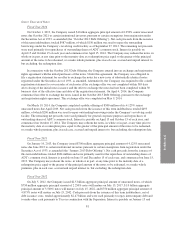ADT 2014 Annual Report Download - page 137
Download and view the complete annual report
Please find page 137 of the 2014 ADT annual report below. You can navigate through the pages in the report by either clicking on the pages listed below, or by using the keyword search tool below to find specific information within the annual report.
FORM 10-K
selling, general and administrative expenses in the Consolidated and Combined Statements of Operations. The
allocation of interest expense from Tyco was based on an assessment of the Company’s share of Tyco’s external
debt using historical data. During fiscal year 2012, the Company was allocated $64 million of interest expense
incurred by Tyco. See Note 5 for information on interest expense.
The Company has a 52- or 53-week fiscal year that ends on the last Friday in September. Fiscal years 2014,
2013 and 2012 were 52-week years.
The Company conducts business in one operating segment, which is identified by the Company based on
how resources are allocated and operating decisions are made. Management evaluates performance and allocates
resources based on the Company as a whole.
The Company conducts business through its operating entities. All intercompany transactions have been
eliminated. The results of companies acquired during the year are included in the Consolidated and Combined
Financial Statements from the effective date of acquisition.
Use of Estimates—The preparation of the Consolidated and Combined Financial Statements in conformity
with GAAP requires management to make estimates and assumptions that affect the reported amount of assets
and liabilities, disclosure of contingent assets and liabilities and reported amounts of revenue and expenses.
Significant estimates in these Consolidated and Combined Financial Statements include, but are not limited to,
estimates of future cash flows and valuation related assumptions associated with asset impairment testing, useful
lives and methods for depreciation and amortization, loss contingencies, income taxes and tax valuation
allowances and purchase price allocation. Actual results could differ materially from these estimates.
Revenue Recognition—Substantially all of the Company’s revenue is generated by contractual monthly
recurring fees received for monitoring services provided to customers. Revenue from monitoring services is
recognized as those services are provided to customers. Customer billings for services not yet rendered are
deferred and recognized as revenue as the services are rendered. The balance of deferred revenue is included in
current liabilities or long-term liabilities, as appropriate.
For transactions in which the Company retains ownership of the security system, non-refundable fees
(referred to as deferred subscriber acquisition revenue) received in connection with the initiation of a monitoring
contract are deferred and amortized over the estimated life of the customer relationship. Transactions in which
the Company transfers ownership of the security system to the customer occur only in certain limited
circumstances.
Early termination of the contract by the customer results in a termination charge in accordance with the
customer contract, which is recognized when collectability is reasonably assured. The amounts of contract
termination charges recognized in revenue during fiscal years 2014, 2013 and 2012 were not material.
Advertising—Advertising costs which amounted to $168 million, $163 million and $155 million for fiscal
years 2014, 2013 and 2012, respectively, are expensed when incurred and are included in selling, general and
administrative expenses.
Radio Conversion Costs—During fiscal year 2013, the Company implemented a three-year conversion
program to replace 2G cellular technology used in many of its security systems. During fiscal year 2014, the
Company incurred charges related to the conversion program of $44 million. There were no charges incurred for
fiscal year 2013. These costs are reflected in radio conversion costs in the Consolidated and Combined
Statements of Operations.
Separation Costs—Charges incurred directly related to the Separation are reflected in Separation costs in
the Company’s Consolidated and Combined Statements of Operations.
71





